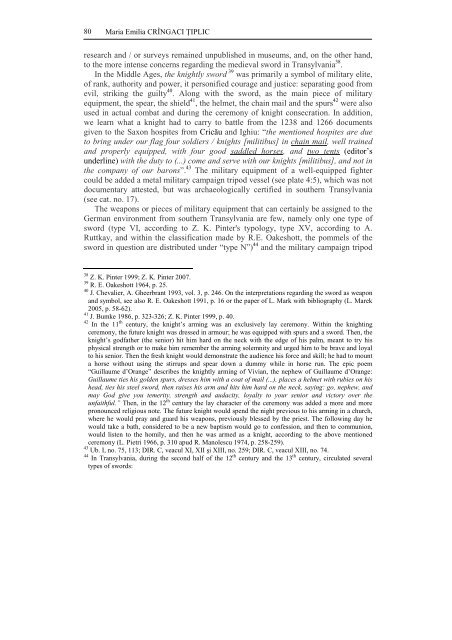Download - Facultatea de Științe Socio-Umane - Universitatea ...
Download - Facultatea de Științe Socio-Umane - Universitatea ...
Download - Facultatea de Științe Socio-Umane - Universitatea ...
You also want an ePaper? Increase the reach of your titles
YUMPU automatically turns print PDFs into web optimized ePapers that Google loves.
80<br />
Maria Emilia CRÎNGACI ŢIPLIC<br />
research and / or surveys remained unpublished in museums, and, on the other hand,<br />
to the more intense concerns regarding the medieval sword in Transylvania 38 .<br />
In the Middle Ages, the knightly sword 39 was primarily a symbol of military elite,<br />
of rank, authority and power, it personified courage and justice: separating good from<br />
evil, striking the guilty 40 . Along with the sword, as the main piece of military<br />
equipment, the spear, the shield 41 , the helmet, the chain mail and the spurs 42 were also<br />
used in actual combat and during the ceremony of knight consecration. In addition,<br />
we learn what a knight had to carry to battle from the 1238 and 1266 documents<br />
given to the Saxon hospites from Cricău and Ighiu: “the mentioned hospites are due<br />
to bring un<strong>de</strong>r our flag four soldiers / knights [militibus] in chain mail, well trained<br />
and properly equipped, with four good saddled horses, and two tents (editor’s<br />
un<strong>de</strong>rline) with the duty to (...) come and serve with our knights [militibus], and not in<br />
the company of our barons”. 43 The military equipment of a well-equipped fighter<br />
could be ad<strong>de</strong>d a metal military campaign tripod vessel (see plate 4:5), which was not<br />
documentary attested, but was archaeologically certified in southern Transylvania<br />
(see cat. no. 17).<br />
The weapons or pieces of military equipment that can certainly be assigned to the<br />
German environment from southern Transylvania are few, namely only one type of<br />
sword (type VI, according to Z. K. Pinter's typology, type XV, according to A.<br />
Ruttkay, and within the classification ma<strong>de</strong> by R.E. Oakeshott, the pommels of the<br />
sword in question are distributed un<strong>de</strong>r “type N”) 44 and the military campaign tripod<br />
38 Z. K. Pinter 1999; Z. K. Pinter 2007.<br />
39 R. E. Oakeshott 1964, p. 25.<br />
40 J. Chevalier, A. Gheerbrant 1993, vol. 3, p. 246. On the interpretations regarding the sword as weapon<br />
and symbol, see also R. E. Oakeshott 1991, p. 16 or the paper of L. Mark with bibliography (L. Marek<br />
2005, p. 58-62).<br />
41 J. Bumke 1986, p. 323-326; Z. K. Pinter 1999, p. 40.<br />
42 In the 11 th century, the knight’s arming was an exclusively lay ceremony. Within the knighting<br />
ceremony, the future knight was dressed in armour; he was equipped with spurs and a sword. Then, the<br />
knight’s godfather (the senior) hit him hard on the neck with the edge of his palm, meant to try his<br />
physical strength or to make him remember the arming solemnity and urged him to be brave and loyal<br />
to his senior. Then the fresh knight would <strong>de</strong>monstrate the audience his force and skill; he had to mount<br />
a horse without using the stirrups and spear down a dummy while in horse run. The epic poem<br />
“Guillaume d’Orange” <strong>de</strong>scribes the knightly arming of Vivian, the nephew of Guillaume d’Orange:<br />
Guillaume ties his gol<strong>de</strong>n spurs, dresses him with a coat of mail (...), places a helmet with rubies on his<br />
head, ties his steel sword, then raises his arm and hits him hard on the neck, saying: go, nephew, and<br />
may God give you temerity, strength and audacity, loyalty to your senior and victory over the<br />
unfaithful.” Then, in the 12 th century the lay character of the ceremony was ad<strong>de</strong>d a more and more<br />
pronounced religious note. The future knight would spend the night previous to his arming in a church,<br />
where he would pray and guard his weapons, previously blessed by the priest. The following day he<br />
would take a bath, consi<strong>de</strong>red to be a new baptism would go to confession, and then to communion,<br />
would listen to the homily, and then he was armed as a knight, according to the above mentioned<br />
ceremony (L. Pietri 1966, p. 310 apud R. Manolescu 1974, p. 258-259).<br />
43 Ub. I, no. 75, 113; DIR. C, veacul XI, XII şi XIII, no. 259; DIR. C, veacul XIII, no. 74.<br />
44 In Transylvania, during the second half of the 12 th century and the 13 th century, circulated several<br />
types of swords:





